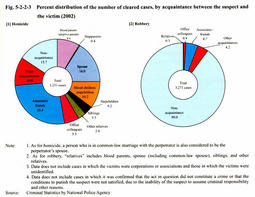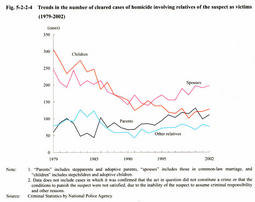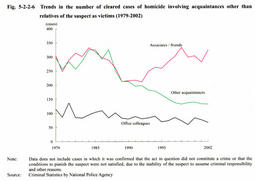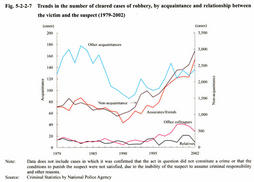| Previous Next Index Image Index Year Selection | |
|
|
2 Acquaintance between suspected perpetrator and victim Intimacy between the suspected perpetrator and the victim differs depending on the type of offense. Homicide is often committed with a certain motivation arising from a conflict of interests or close relationship between the suspected perpetrator and the victim, and therefore the rate of victims who were acquaintances (including relatives) of the suspected perpetrators (acquaintance rate) is extremely high. On the other hand, robbery is often committed for the purpose of taking money or articles in the presence of the victim, and due to such nature of the offense, the acquaintance rate is extremely low because acquaintance with the victim would cause the perpetrator to be cleared by the investigating authorities. Bodily injury and extortion exist in between homicide and robbery and therefore these offenses may be committed against victims who are or are not acquainted with the perpetrators.
Fig. 5-2-2-2 shows the trends in the acquaintance rate for these offenses. The acquaintance rate for homicide has remained at a high level of over 80% whereas the rate for robbery has been at a low level between 10% and 20% and the rate for bodily injury and the rate for extortion have been fluctuating at around 50% and within a range between 30% and 50% respectively. Fig. 5-2-2-2 Trends in the rate of acquaintance between the suspect and the victim, by type of offense (1979-2002) Fig. 5-2-2-3 shows the percent distribution of the number of cleared cases of homicide and robbery in 2002, by acquaintance and relationship between the suspected perpetrator and the victim. As for homicide, 41.6% of victims were relatives of the perpetrators and 31.9% were associates, friends, or office colleagues of the perpetrators whereas 15.7% were involved in random killings committed by non-acquaintances. As for robbery, 90.0% of victims were not acquainted with the perpetrators, and most of victims who were acquainted with the perpetrators were friends or associates whereas relatives had quite a small share.Fig. 5-2-2-3 Percent distribution of the number of cleared cases, by acquaintance between the suspect and the victim (2002) Fig. 5-2-2-4 shows the trends in the number of cleared cases of homicide involving relatives of the suspected perpetrators as victims. The number of cases involving children of the perpetrators as victims has been declining since 1979, and the number in 2002 accounted for only 41.8% of that in 1979. The major reasons for this decline are the falling birthrate and the decrease in the number of infanticide cases in which infants under 1 year of age were killed. Fig. 5-2-2-5 shows the trends in the number of victims of infanticide and the number of births, indicating almost the same trend as the declining trend in the number of cases involving children of the perpetrators as victims.The number of cleared cases involving spouses of the suspected perpetrators as victims continued to decline until 1993 and then took an upward turn. In 2002, the number increased by 41.7% from 1993. The number of cleared cases involving parents of the perpetrators as victims fluctuated repeatedly until 1991 and then took an upward turn. In 2002, the number increased by 63.2% from 1991, suggesting that domestic conflict often result in the killing of spouses and parents. Fig. 5-2-2-4 Trends in the number of cleared cases of homicide involving relatives of the suspect as victims (1979-2002) Fig. 5-2-2-5 Trends in the number of victims of infanticide and the number of births (1979-2002) Fig. 5-2-2-6 shows the trends in the number of cleared cases of homicide involving acquaintances other than relatives of the suspected perpetrators as victims. The number of cases involving friends or associates of the perpetrators as victims declined gradually after peaking in 1984 but it has been on the rise since 1993, increasing by 30.5% over the 10 years until 2002, whereas the number of cases involving office colleagues of the perpetrators as victims remained almost flat and the number of cases involving as victims other acquaintances of the perpetrators, who were most distantly related to the perpetrators, has been on the decline, in contrast with the trend in the number of cases involving friends or associates.Considering these trends in combination with the upward trend in the number of cases involving parents and spouses of the perpetrators as victims, the tendency for people who are more closely related to the suspected perpetrators to be targeted and victimized more frequently has been gradually intensifying. Fig. 5-2-2-7 shows the relationship between the victim and the suspected perpetrator in the case of robbery. Due to the nature of the offense, the overwhelming majority of victims are non-acquaintances of the perpetrators. The number of cleared cases involving non-acquaintances of the perpetrators has been on the rise since 1990, increasing 3.1-fold from 1989 in 2002. Accordingly, the number of cases involving acquaintances of the perpetrators has also been increasing since 1992; the number of cases involving associates or friends of the perpetrators increased 3.6-fold from 1990 to 2002 and the number of cases involving other acquaintances of the perpetrators has also been on the rise. Such change in the trend relating to the relationship between the victim and the suspected perpetrator indicates that the number of offenders who commit robbery even targeting their friends or associates has been increasing constantly. Furthermore, in robbery cases involving acquaintances, the perpetrators inherently tend to commit the offense in a more malicious manner, such as causing serious harm to the victims' lives or bodies out of fear that their commitment of the crime would be revealed, and this tendency is a dangerous sign that should not be disregarded despite the small number of such cases (as shown in the special survey mentioned later in Chapter 5,60% of malicious cases of homicide on the occasion of robbery for which death penalty or life imprisonment was demanded by prosecutors were committed by acquaintances of the victims). Fig. 5-2-2-6 Trends in the number of cleared cases of homicide involving acquaintances other than relatives of the suspect as victims (1979-2002) Fig. 5-2-2-7 Trends in the number of cleared cases of robbery, by acquaintance and relationship between the victim and the suspect (1979-2002) |





